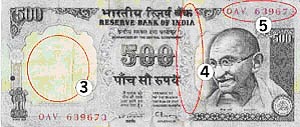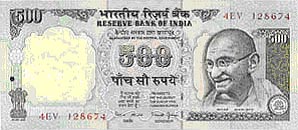Last updated: 06-Aug-2009 18:10 IST
Despite of skillfully forging a currency note, the genuineness cannot be achieved. The differences will be due to the Paper Ink, Human Element and above all Unavailability of the Security Measures taken by the Currency Press by the Government. The genuine notes are made of a special type of paper which is manufactured in Security Paper Mill, Hoshangabad (Madhya Pradesh).
In printing, multi-coloured impressions are used with the
intaglio printing press. The forgers use various methods for making the
counterfeit currency viz.
-
Photographic Method
-
Process made Forgery
-
Hand engraved blocks
-
Lithographic Process
-
Hand Drawn Forgery
Forged notes usually exhibit certain characteristic differences which
facilitates easy identification. There are number of distinguishable features
when compared with genuine notes.
Following differentiating features are found:
Original Currency (click the above image)

Fake Currency
-
Size: While cutting in bundles the size of the forged notes are not same, while the size of genuine currency is fixed.
-
Size of Printed Design: The technique used for printing the genuine notes is highly sophisticated. It gives each and every line in printing with cleat and sharp images. It is not possible with the counterfeit currency.
-
Watermark: In counterfeit notes, the watermark is made by using Opaque Ink, painting with white solution, stamping a die, engraved with the picture of Mahatma Gandhi and also by applying oil, grease or wax to give the transparent image of Mahatma Gandhi.
-
Security Thread: In genuine notes, the security thread is incorporated into the paper at the time of manufacture of the paper. The security thread in counterfeit notes is imitated by drawing a line by pencil or printing a line with grey ink or by using an aluminum thread while pasting two thin sheets of paper. In genuine notes over security thread one can read the word RBI and BHARAT (in Hindi - भारत )
-
Numbering: In counterfeit currency it is difficult to reproduce the same shape of individual numbers again and again with accuracy. The alignment of figures is also difficult to maintain by the forgers. Spreading of Ink, Smaller or Bigger Number, Inadequate gaps, and Different alignments in numbers can be regarded with suspicion.
-
Quality of Printing: In counterfeit notes the printed lines will be broken and there may also be smudging of Ink.
Other Techniques
-
Serial numbers are printed with fluorescent ink which can be seen when viewed under a ultra-violet lens.
-
Floral design on the left side- half the denomination of the currency will be printed on the front side and the other half on the back side. If seen against bright light, the complete denomination appears.
-
Just below the floral print, a mark is made in Intaglio (a kind of printing where the image is slightly raised) for the visually-impaired to identify the denomination. For the Rs. 500 note, the mark is a CIRCLE, for the Rs. 100, it is a TRIANGLE and a SQUARE for the Rs. 50.
-
Similarly, a portrait of Mahatma Gandhi, the RBI Seal, a guarantee and promise clause, an Ashoka Pillar emblem on the left and RBI Governor's signature are all printed on Intaglio.
-
A band printed on the right side contains a latent image of the denomination of the banknote. The numeral appears when the currency is held horizontally at the eye level.
-
A wide security thread with inscriptions भारत (BHARAT) in Hindi and RBI runs through the banknote. The thread fluoresces on both sides in Ultra-violet light.
Electronic Gadgets for
Sophisticated Identification
Fake currency testing machines can be bought from most
electronics goods shops in the state for Rs.1,500 to Rs.4,000. The
machines which have found the maximum takers are made by companies like
-
Methodex System,
-
Godrej, and
-
Klick
Klick's Marketing Manager
Ashwani Sahay told that the ultra-violet rays emanating from the machine could
help detect fake currency. But not everyone can afford these machines, and small
shopkeepers and roadside vendors have found an ingenious way to detect fake
currency - laser torches, which can be bought from any electronic shop
for Rs.10 to Rs.40.
